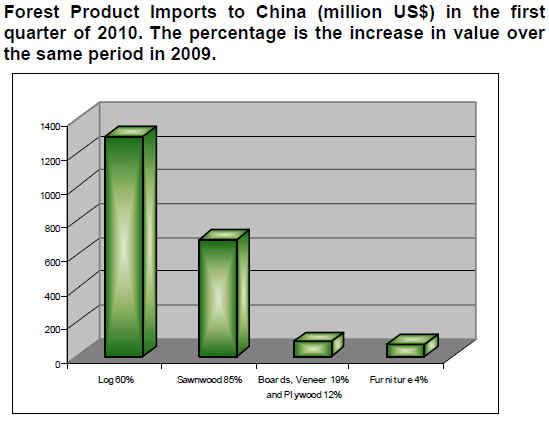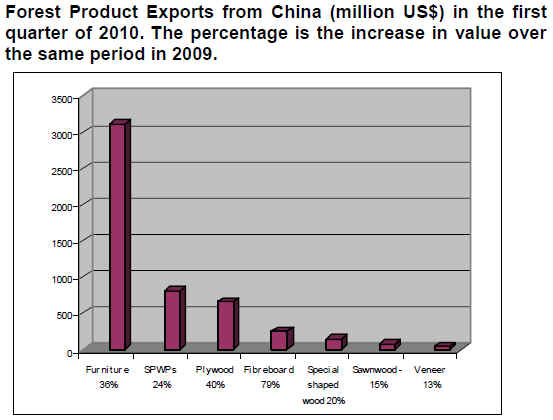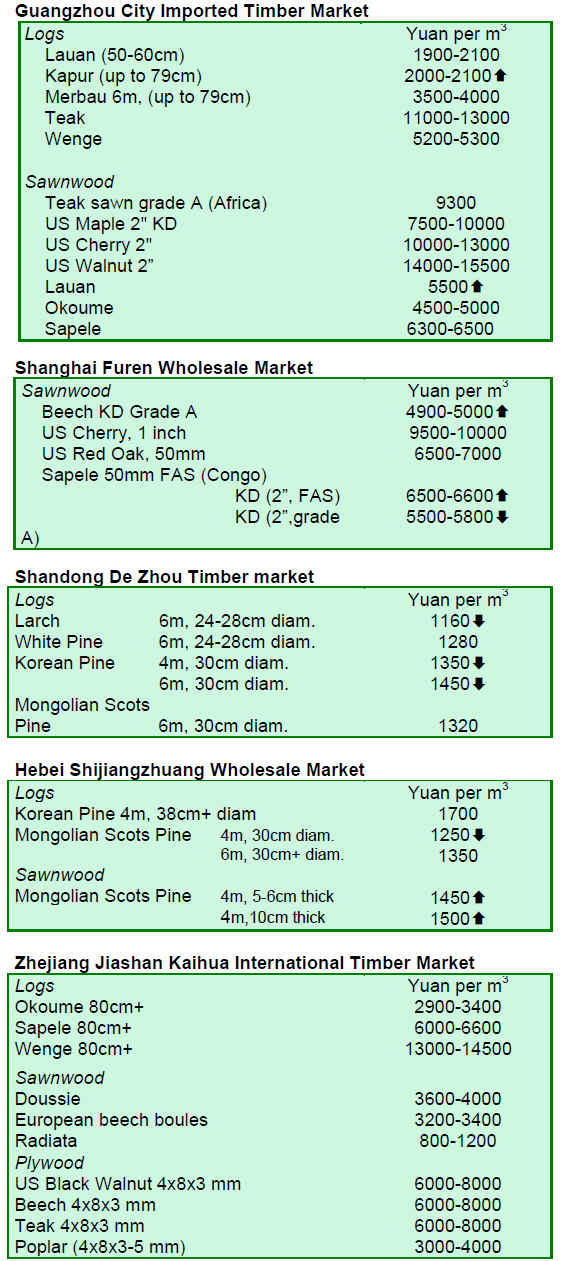|
First quarter imports soar
In the first quarter of 2010, total log imports to China were 7.7 million cu.m valued at US$1.3 billion, up 37% in volume and 60% in value over the same period last year.
Of the total, log imports from Russia rose 5% to 3.5 million cu.m, imports from New Zealand soared 144% to 1.3 million cu.m and imports from Malaysia increased 144% to 264,200 cu.m.
Tropical log imports amounted to 2 million cu.m, increasing 48% over the last year. Tropical logs accounted for 27% share of the total exports.
Sawnwood imports
Around 3 million cu.m of sawnwood (including sleepers) valued at US$691 million were imported in the first quarter of 2010. Sawnwood imports increased 83% in volume and 85% in value over the first quarter period last year.
Russia, the major supplier of sawnwood, saw China’s imports increase by 40% from the same period last year. Canada, USA and Thailand also improved their exports to China significantly.
Imports of panels, veneer and plywood
Veneer imports amounted to 9 200 tonnes (US$15 million) rising 13% in volume and 19% in value during the first quarter of 2010.
Particleboard imports followed the trend increasing 83% in volume and 85% in value totalling 73,500 tonnes valued at US$23 million.
On the other hand, fibreboard imports showed more moderate increase, up 5% in volume and 10% in value. The total imports were 54,500 tonnes valued at US$26 million.
Similarly, plywood imports were 40,100 cu.m in volume and US$22 million in value, increasing 20% and 12% respectively over the same period.
SPWPs and wooden furniture imports
Imports of secondary processed wood products (SPWPs) including wooden doors, windows, knockdown kitchen furniture, handicraft and packaging etc. amounted to US$23 million, up 45% over the same period last year.
The first quarter furniture imports by China were valued at US$72 million. These imports included wooden frame seats, office furniture, kitchen furniture and bedroom furniture. China’s furniture imports were up 4% in value from the same period last year.

Sharp increase in exports
The total value of wooden furniture exported was US$3,119 million, up 36% from the first quarter period of last year. Data from China Customs showed that wooden furniture is still the major timber product exported.
The second largest export category was other SPWPs including wooden doors and windows, flooring, wooden handicrafts and wooden packaging. A total of US$808 million was exported in this category, up 24% over the same period in 2009.
Similarly, plywood exports increased considerably in the first quarter of 2010. A total of 1.4 million cu.m valued at US$649 million of plywood was exported, an increase of 46% in volume and 40% in value over the same period in 2009. Plywood exports to the US were 252,600 cu.m, up 13%. China’s exports to the US accounted for 18% of total plywood exports. Exports to United Arab Emirates, UK,Japan and Korea also rose 110%, 85%, 68% and 83% respectively.
Other wood product exports were 436,800 tonnes of fibreboard (US$247 million, up 79%), 97,500 tonnes of mouldings (US$148 million, up 20%), 114,800 cu.m of sawnwood (US$72 million, down 15%) and 20,900 tonnes of veneer (US$43 million, up 13%).

Developments and problems of wooden door industry
The rapid economic growth and fast development of the construction sector have resulted in the rapid expansion of China’s wooden door industry which has grown at the annual rate of 20% over the last ten years. According to available statistics, the output of this industry amounted to 60 billion Yuan in 2009, up 20% over the year before. The value of exports was 3.1 billion Yuan, accounting for 5% of the total output value.
However, according to analysts domestic production of wooden doors could not still meet the huge domestic demand. The annual consumption of doors is approximately 100 million square metres or 60-70 million door sets each year. The domestic production capacity, say local analysts, can only meet less than one-third of the total demand.
Over half of the 5,000 wooden door manufacturers in China are not able to produce to a standard demanded by consumers. Problems such as low efficiency, poor quality and varying industry standards are some of the limiting factors.
Wood Plastic Composite emerging
Wood plastic composite (WPC), a material made of waste wood and waste recyclable plastic is said to combine the best properties of both wood and plastic.
In China, about 2.5 million tonnes of waste plastic, over 8 million tonnes of waste wood, 10 million tonnes of logging residues, 200 million tonnes of crop stalks and 35 million tonnes of rice husk are produced each year. There is thus a huge potential in recovery and utilisation of residues.
China has limited wood resources relative to its needs and the Chinese government has been supporting the recovery and integrated utilisation of wood. As a result, rapid progress has been made in the development of wood plastic composites.
It is reported that China currently has 170 enterprises producing wood plastic composites with an annual output value of RMB 1 200 million, the second largest production in the world.
Experts believe that this industry will grow at a rate of 30–50% annually in the near future.

|